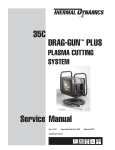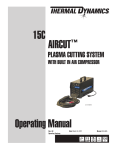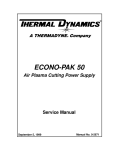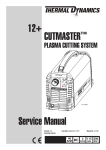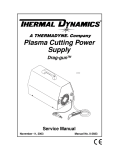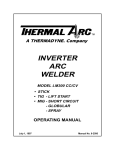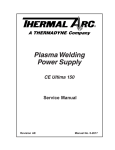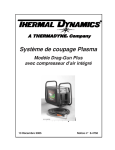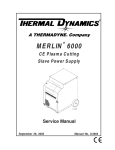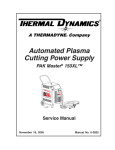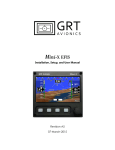Download Thermal Dynamics Drag-Gun PLUS 35C
Transcript
35C DRAG-GUN PLUS ™ PLASMA CUTTING SYSTEM Service Manual Rev. AB Operating Features: Issue Date: October 18, 2007 PLASMA Manual 0-4751 ! WARNING Read and understand this entire Manual and your employer’s safety practices before installing, operating, or servicing the equipment. While the information contained in this Manual represents the Manufacturer's best judgement, the Manufacturer assumes no liability for its use. Plasma Cutting Power Supply Drag-Gun Plus 35C PCH 42 Torch Service Manual Number 0-4751 Covered under U.S. Patents. Published by: Thermadyne Corporation 82 Benning Street West Lebanon, New Hampshire, USA 03784 (603) 298-5711 www.thermal-dynamics.com ©Copyright 2006, 2007 by Thermal Dynamics Corporation All rights reserved. Reproduction of this work, in whole or in part, without written permission of the publisher is prohibited. The publisher does not assume and hereby disclaims any liability to any party for any loss or damage caused by any error or omission in this Manual, whether such error results from negligence, accident, or any other cause. Printed in the United States of America Publication Date: October 18, 2007 Record the following information for Warranty purposes: Where Purchased:____________________________________ Purchase Date:_______________________________________ Power Supply Serial #:________________________________ Torch Serial #:________________________________________ TABLE OF CONTENTS SECTION 1: GENERAL INFORMATION ................................................................................................ 1-1 1.01 1.02 1.03 1.04 1.05 1.06 1.06 1.05 Notes, Cautions and Warnings ...................................................................... Important Safety Precautions ....................................................................... Publications .................................................................................................. Note, Attention et Avertissement .................................................................. Precautions De Securite Importantes ........................................................... Documents De Reference ............................................................................. Declaration Of Conformity ............................................................................. Statement of Warranty .................................................................................. 1-1 1-1 1-2 1-3 1-3 1-4 1-6 1-7 SECTION 2: INTRODUCTION ............................................................................................................... 2-1 2.01 2.02 2.03 2.04 2.05 2.06 INTRODUCTION .......................................................................................... GENERAL SPECIFICATION ......................................................................... Features ....................................................................................................... Torch Specifications ..................................................................................... System Contents .......................................................................................... Transporting Methods ................................................................................... 2-1 2-1 2-1 2-2 2-2 2-2 SECTION 3: INSTALLATION ................................................................................................................. 3-1 3.01 Site Selection ............................................................................................... 3-1 3.02 Electrical Input Connections ......................................................................... 3-1 3.03 Torch ............................................................................................................ 3-1 SECTION 4: OPERATION .................................................................................................................... 4-1 4.01 Front Control Panel ....................................................................................... 4-1 4.02 Preparations For Operating ........................................................................... 4-2 SECTION 5: MAINTENANCE .................................................................................................... 5-1 5.01 General Maintenance .................................................................................... 5-1 SECTION 6: TROUBLESHOOTING ....................................................................................................... 6-1 6.01 6.02 6.03 6.04 6.05 6.06 Normal Setup and Operation ........................................................................ Basic Trouble Shooting Guide ....................................................................... Control PCB Indicators ................................................................................. Open Circuit Voltage Check .......................................................................... Detailed Fault Finding / Error Indicators ........................................................ Torch Tests ................................................................................................... 6-1 6-2 6-3 6-4 6-5 6-9 SECTION 7: PARTS LIST ...................................................................................................................... 7-1 7.01 Parts List Power Supply ................................................................................ 7-2 7.02 Replacement Hand Torch Parts With Ergonomic Handle ................................ 7-6 TABLE OF CONTENTS (Con't) Appendix 1: Operating Sequence, Block Diagram ..................................................................... A-1 Appendix 2: Torch Connection ................................................................................................... A-2 Appendix 3: Microchip Pin-Out .................................................................................................. A-3 Appendix 4: System Schematic 230V CE ................................................................................. A-4 Appendix 5: System Schematic 230V ....................................................................................... A-6 GLOBAL CUSTOMER SERVICE CONTACT INFORMATION .............................. Inside Rear Cover DRAG-GUN PLUS 35C SECTION 1: GENERAL INFORMATION 1.01 • Use an air-supplied respirator if ventilation is not adequate to remove all fumes and gases. • The kinds of fumes and gases from the plasma arc depend on the kind of metal being used, coatings on the metal, and the different processes. You must be very careful when cutting or welding any metals which may contain one or more of the following: Notes, Cautions and Warnings Antimony Arsenic Barium Beryllium Cadmium Throughout this manual, notes, cautions, and warnings are used to highlight important information. These highlights are categorized as follows: NOTE Always read the Material Safety Data Sheets (MSDS) that should be supplied with the material you are using. These MSDSs will give you the information regarding the kind and amount of fumes and gases that may be dangerous to your health. • For information on how to test for fumes and gases in your workplace, refer to item 1 in Subsection 1.03, Publications in this manual. • Use special equipment, such as water or down draft cutting tables, to capture fumes and gases. • Do not use the plasma torch in an area where combustible or explosive gases or materials are located. • Phosgene, a toxic gas, is generated from the vapors of chlorinated solvents and cleansers. Remove all sources of these vapors. • This product, when used for welding or cutting, produces fumes or gases which contain chemicals known to the State of California to cause birth defects and, in some cases, cancer. (California Health & Safety Code Sec. 25249.5 et seq.) CAUTION ! WARNING A procedure which, if not properly followed, may cause injury to the operator or others in the operating area. 1.02 Mercury Nickel Selenium Silver Vanadium • An operation, procedure, or background information which requires additional emphasis or is helpful in efficient operation of the system. A procedure which, if not properly followed, may cause damage to the equipment. Chromium Cobalt Copper Lead Manganese Important Safety Precautions ELECTRIC SHOCK ! WARNING OPERATION AND MAINTENANCE OF PLASMA ARC EQUIPMENT CAN BE DANGEROUS AND HAZARDOUS TO YOUR HEALTH. Electric Shock can injure or kill. The plasma arc process uses and produces high voltage electrical energy. This electric energy can cause severe or fatal shock to the operator or others in the workplace. Plasma arc cutting produces intense electric and magnetic emissions that may interfere with the proper function of cardiac pacemakers, hearing aids, or other electronic health equipment. Persons who work near plasma arc cutting applications should consult their medical health professional and the manufacturer of the health equipment to determine whether a hazard exists. To prevent possible injury, read, understand and follow all warnings, safety precautions and instructions before using the equipment. Call 1-603-298-5711 or your local distributor if you have any questions. • Never touch any parts that are electrically “live” or “hot.” • Wear dry gloves and clothing. Insulate yourself from the work piece or other parts of the welding circuit. • Repair or replace all worn or damaged parts. • Extra care must be taken when the workplace is moist or damp. • Install and maintain equipment according to NEC code, refer to item 9 in Subsection 1.03, Publications. • Disconnect power source before performing any service or repairs. • Read and follow all the instructions in the Operating Manual. FIRE AND EXPLOSION GASES AND FUMES Fire and explosion can be caused by hot slag, sparks, or the plasma arc. • Be sure there is no combustible or flammable material in the workplace. Any material that cannot be removed must be protected. • Ventilate all flammable or explosive vapors from the workplace. • Do not cut or weld on containers that may have held combustibles. Gases and fumes produced during the plasma cutting process can be dangerous and hazardous to your health. • Keep all fumes and gases from the breathing area. Keep your head out of the welding fume plume. Manual 0-4751 1-1 GENERAL INFORMATION DRAG-GUN PLUS 35C • Provide a fire watch when working in an area where fire hazards may exist. • Hydrogen gas may be formed and trapped under aluminum workpieces when they are cut underwater or while using a water table. DO NOT cut aluminum alloys underwater or on a water table unless the hydrogen gas can be eliminated or dissipated. Trapped hydrogen gas that is ignited will cause an explosion. NOISE Noise can cause permanent hearing loss. Plasma arc processes can cause noise levels to exceed safe limits. You must protect your ears from loud noise to prevent permanent loss of hearing. • To protect your hearing from loud noise, wear protective ear plugs and/or ear muffs. Protect others in the workplace. • Noise levels should be measured to be sure the decibels (sound) do not exceed safe levels. • For information on how to test for noise, see item 1 in Subsection 1.03, Publications, in this manual. Plasma Arc Rays can injure your eyes and burn your skin. The plasma arc process produces very bright ultra violet and infra red light. These arc rays will damage your eyes and burn your skin if you are not properly protected. • To protect your eyes, always wear a welding helmet or shield. Also always wear safety glasses with side shields, goggles or other protective eye wear. • Wear welding gloves and suitable clothing to protect your skin from the arc rays and sparks. • Keep helmet and safety glasses in good condition. Replace lenses when cracked, chipped or dirty. • Protect others in the work area from the arc rays. Use protective booths, screens or shields. • Use the shade of lens as suggested in the following per ANSI/ ASC Z49.1: Arc Current Minimum Protective Shade No. Suggested Shade No. Less Than 300* 8 9 300 - 400* 9 12 400 - 800* 10 14 *These values apply where the actual arc is clearly seen. Experience has shown that lighter filters may be used when the arc is hidden by the workpiece. Publications Refer to the following standards or their latest revisions for more information: 1. OSHA, SAFETY AND HEALTH STANDARDS, 29CFR 1910, obtainable from the Superintendent of Documents, U.S. Government Printing Office, Washington, D.C. 20402 GENERAL INFORMATION 3. NIOSH, SAFETY AND HEALTH IN ARC WELDING AND GAS WELDING AND CUTTING, obtainable from the Superintendent of Documents, U.S. Government Printing Office, Washington, D.C. 20402 4. ANSI Standard Z87.1, SAFE PRACTICES FOR OCCUPATION AND EDUCATIONAL EYE AND FACE PROTECTION, obtainable from American National Standards Institute, 1430 Broadway, New York, NY 10018 5. ANSI Standard Z41.1, STANDARD FOR MEN’S SAFETY-TOE FOOTWEAR, obtainable from the American National Standards Institute, 1430 Broadway, New York, NY 10018 6. ANSI Standard Z49.2, FIRE PREVENTION IN THE USE OF CUTTING AND WELDING PROCESSES, obtainable from American National Standards Institute, 1430 Broadway, New York, NY 10018 7. AWS Standard A6.0, WELDING AND CUTTING CONTAINERS WHICH HAVE HELD COMBUSTIBLES, obtainable from American Welding Society, 550 N.W. LeJeune Rd, Miami, FL 33126 PLASMA ARC RAYS 1.03 2. ANSI Standard Z49.1, SAFETY IN WELDING AND CUTTING, obtainable from the American Welding Society, 550 N.W. LeJeune Rd, Miami, FL 33126 8. NFPA Standard 51, OXYGEN-FUEL GAS SYSTEMS FOR WELDING, CUTTING AND ALLIED PROCESSES, obtainable from the National Fire Protection Association, Batterymarch Park, Quincy, MA 02269 9. NFPA Standard 70, NATIONAL ELECTRICAL CODE, obtainable from the National Fire Protection Association, Batterymarch Park, Quincy, MA 02269 10. NFPA Standard 51B, CUTTING AND WELDING PROCESSES, obtainable from the National Fire Protection Association, Batterymarch Park, Quincy, MA 02269 11. CGA Pamphlet P-1, SAFE HANDLING OF COMPRESSED GASES IN CYLINDERS, obtainable from the Compressed Gas Association, 1235 Jefferson Davis Highway, Suite 501, Arlington, VA 22202 12. CSA Standard W117.2, CODE FOR SAFETY IN WELDING AND CUTTING, obtainable from the Canadian Standards Association, Standards Sales, 178 Rexdale Boulevard, Rexdale, Ontario, Canada M9W 1R3 13. NWSA booklet, WELDING SAFETY BIBLIOGRAPHY obtainable from the National Welding Supply Association, 1900 Arch Street, Philadelphia, PA 19103 14. American Welding Society Standard AWSF4.1, RECOMMENDED SAFE PRACTICES FOR THE PREPARATION FOR WELDING AND CUTTING OF CONTAINERS AND PIPING THAT HAVE HELD HAZARDOUS SUBSTANCES, obtainable from the American Welding Society, 550 N.W. LeJeune Rd, Miami, FL 33126 15. ANSI Standard Z88.2, PRACTICE FOR RESPIRATORY PROTECTION, obtainable from American National Standards Institute, 1430 Broadway, New York, NY 10018 1-2 Manual 0-4751 DRAG-GUN PLUS 35C 1.04 Note, Attention et Avertissement Dans ce manuel, les mots “note,” “attention,” et “avertissement” sont utilisés pour mettre en relief des informations à caractère important. Ces mises en relief sont classifiées comme suit : NOTE • Eloignez toute fumée et gaz de votre zone de respiration. Gardez votre tête hors de la plume de fumée provenant du chalumeau. • Utilisez un appareil respiratoire à alimentation en air si l’aération fournie ne permet pas d’éliminer la fumée et les gaz. • Les sortes de gaz et de fumée provenant de l’arc de plasma dépendent du genre de métal utilisé, des revêtements se trouvant sur le métal et des différents procédés. Vous devez prendre soin lorsque vous coupez ou soudez tout métal pouvant contenir un ou plusieurs des éléments suivants: Toute opération, procédure ou renseignement général sur lequel il importe d’insister davantage ou qui contribue à l’efficacité de fonctionnement du système. antimoine argent arsenic baryum béryllium ATTENTION Toute procédure pouvant résulter l’endommagement du matériel en cas de non-respect de la procédure en question. ! 1.05 Lisez toujours les fiches de données sur la sécurité des matières (sigle américain “MSDS”); celles-ci devraient être fournies avec le matériel que vous utilisez. Les MSDS contiennent des renseignements quant à la quantité et la nature de la fumée et des gaz pouvant poser des dangers de santé. • Pour des informations sur la manière de tester la fumée et les gaz de votre lieu de travail, consultez l’article 1 et les documents cités à la page 5. • Utilisez un équipement spécial tel que des tables de coupe à débit d’eau ou à courant descendant pour capter la fumée et les gaz. • N’utilisez pas le chalumeau au jet de plasma dans une zone où se trouvent des matières ou des gaz combustibles ou explosifs. • Le phosgène, un gaz toxique, est généré par la fumée provenant des solvants et des produits de nettoyage chlorés. Eliminez toute source de telle fumée. • Ce produit, dans le procéder de soudage et de coupe, produit de la fumée ou des gaz pouvant contenir des éléments reconnu dans L’état de la Californie, qui peuvent causer des défauts de naissance et le cancer. (La sécurité de santé en Californie et la code sécurité Sec. 25249.5 et seq.) Precautions De Securite Importantes AVERTISSEMENTS L’OPÉRATION ET LA MAINTENANCE DU MATÉRIEL DE SOUDAGE À L’ARC AU JET DE PLASMA PEUVENT PRÉSENTER DES RISQUES ET DES DANGERS DE SANTÉ. Coupant à l’arc au jet de plasma produit de l’énergie électrique haute tension et des émissions magnétique qui peuvent interférer la fonction propre d’un “pacemaker” cardiaque, les appareils auditif, ou autre matériel de santé electronique. Ceux qui travail près d’une application à l’arc au jet de plasma devrait consulter leur membre professionel de médication et le manufacturier de matériel de santé pour déterminer s’il existe des risques de santé. Il faut communiquer aux opérateurs et au personnel TOUS les dangers possibles. Afin d’éviter les blessures possibles, lisez, comprenez et suivez tous les avertissements, toutes les précautions de sécurité et toutes les consignes avant d’utiliser le matériel. Composez le + 603-298-5711 ou votre distributeur local si vous avez des questions. FUMÉE et GAZ La fumée et les gaz produits par le procédé de jet de plasma peuvent présenter des risques et des dangers de santé. Manual 0-4751 nickel plomb sélénium vanadium • AVERTISSEMENT Toute procédure pouvant provoquer des blessures de l’opérateur ou des autres personnes se trouvant dans la zone de travail en cas de non-respect de la procédure en question. cadmium mercure chrome cobalt cuivre manganèse CHOC ELECTRIQUE Les chocs électriques peuvent blesser ou même tuer. Le procédé au jet de plasma requiert et produit de l’énergie électrique haute tension. Cette énergie électrique peut produire des chocs graves, voire mortels, pour l’opérateur et les autres personnes sur le lieu de travail. • Ne touchez jamais une pièce “sous tension” ou “vive”; portez des gants et des vêtements secs. Isolez-vous de la pièce de travail ou des autres parties du circuit de soudage. • Réparez ou remplacez toute pièce usée ou endommagée. • Prenez des soins particuliers lorsque la zone de travail est humide ou moite. • Montez et maintenez le matériel conformément au Code électrique national des Etats-Unis. (Voir la page 5, article 9.) • Débranchez l’alimentation électrique avant tout travail d’entretien ou de réparation. • Lisez et respectez toutes les consignes du Manuel de consignes. 1-3 GENERAL INFORMATION DRAG-GUN PLUS 35C INCENDIE ET EXPLOSION BRUIT Les incendies et les explosions peuvent résulter des scories chaudes, des étincelles ou de l’arc de plasma. Le procédé à l’arc de plasma produit du métal, des étincelles, des scories chaudes pouvant mettre le feu aux matières combustibles ou provoquer l’explosion de fumées inflammables. Le bruit peut provoquer une perte permanente de l’ouïe. Les procédés de soudage à l’arc de plasma peuvent provoquer des niveaux sonores supérieurs aux limites normalement acceptables. Vous dú4ez vous protéger les oreilles contre les bruits forts afin d’éviter une perte permanente de l’ouïe. • Soyez certain qu’aucune matière combustible ou inflammable ne se trouve sur le lieu de travail. Protégez toute telle matière qu’il est impossible de retirer de la zone de travail. • Pour protéger votre ouïe contre les bruits forts, portez des tampons protecteurs et/ou des protections auriculaires. Protégez également les autres personnes se trouvant sur le lieu de travail. • Procurez une bonne aération de toutes les fumées inflammables ou explosives. • Il faut mesurer les niveaux sonores afin d’assurer que les décibels (le bruit) ne dépassent pas les niveaux sûrs. • Ne coupez pas et ne soudez pas les conteneurs ayant pu renfermer des matières combustibles. • Pour des renseignements sur la manière de tester le bruit, consultez l’article 1, page 5. • Prévoyez une veille d’incendie lors de tout travail dans une zone présentant des dangers d’incendie. 1.06 • Le gas hydrogène peut se former ou s’accumuler sous les pièces de travail en aluminium lorsqu’elles sont coupées sous l’eau ou sur une table d’eau. NE PAS couper les alliages en aluminium sous l’eau ou sur une table d’eau à moins que le gas hydrogène peut s’échapper ou se dissiper. Le gas hydrogène accumulé explosera si enflammé. Consultez les normes suivantes ou les révisions les plus récentes ayant été faites à celles-ci pour de plus amples renseignements : RAYONS D’ARC DE PLASMA Les rayons provenant de l’arc de plasma peuvent blesser vos yeux et brûler votre peau. Le procédé à l’arc de plasma produit une lumière infra-rouge et des rayons ultra-violets très forts. Ces rayons d’arc nuiront à vos yeux et brûleront votre peau si vous ne vous protégez pas correctement. • Pour protéger vos yeux, portez toujours un casque ou un écran de soudeur. Portez toujours des lunettes de sécurité munies de parois latérales ou des lunettes de protection ou une autre sorte de protection oculaire. • Portez des gants de soudeur et un vêtement protecteur approprié pour protéger votre peau contre les étincelles et les rayons de l’arc. • Maintenez votre casque et vos lunettes de protection en bon état. Remplacez toute lentille sale ou comportant fissure ou rognure. • Protégez les autres personnes se trouvant sur la zone de travail contre les rayons de l’arc en fournissant des cabines ou des écrans de protection. • Utilisez la nuance de lentille qui est suggèrée dans le recommendation qui suivent ANSI/ASC Z49.1: Courant Arc Nuance Minimum Protective Numéro Nuance Suggerée Numéro Moins de 300* 8 9 300 - 400* 9 12 400 - 800* 10 14 *Ces valeurs s’appliquent ou l’arc actuel est observé clairement. L’experience a démontrer que les filtres moins foncés peuvent être utilisés quand l’arc est caché par moiceau de travail. GENERAL INFORMATION Documents De Reference 1. OSHA, NORMES DE SÉCURITÉ DU TRAVAIL ET DE PROTECTION DE LA SANTÉ, 29CFR 1910, disponible auprès du Superintendent of Documents, U.S. Government Printing Office, Washington, D.C. 20402 2. Norme ANSI Z49.1, LA SÉCURITÉ DES OPÉRATIONS DE COUPE ET DE SOUDAGE, disponible auprès de la Société Américaine de Soudage (American Welding Society), 550 N.W. LeJeune Rd., Miami, FL 33126 3. NIOSH, LA SÉCURITÉ ET LA SANTÉ LORS DES OPÉRATIONS DE COUPE ET DE SOUDAGE À L’ARC ET AU GAZ, disponible auprès du Superintendent of Documents, U.S. Government Printing Office, Washington, D.C. 20402 4. Norme ANSI Z87.1, PRATIQUES SURES POUR LA PROTECTION DES YEUX ET DU VISAGE AU TRAVAIL ET DANS LES ECOLES, disponible de l’Institut Américain des Normes Nationales (American National Standards Institute), 1430 Broadway, New York, NY 10018 5. Norme ANSI Z41.1, NORMES POUR LES CHAUSSURES PROTECTRICES, disponible auprès de l’American National Standards Institute, 1430 Broadway, New York, NY 10018 6. Norme ANSI Z49.2, PRÉVENTION DES INCENDIES LORS DE L’EMPLOI DE PROCÉDÉS DE COUPE ET DE SOUDAGE, disponible auprès de l’American National Standards Institute, 1430 Broadway, New York, NY 10018 7. Norme A6.0 de l’Association Américaine du Soudage (AWS), LE SOUDAGE ET LA COUPE DE CONTENEURS AYANT RENFERMÉ DES PRODUITS COMBUSTIBLES, disponible auprès de la American Welding Society, 550 N.W. LeJeune Rd., Miami, FL 33126 8. Norme 51 de l’Association Américaine pour la Protection contre les Incendies (NFPA), LES SYSTEMES À GAZ AVEC ALIMENTATION EN OXYGENE POUR LE SOUDAGE, LA COUPE ET LES PROCÉDÉS ASSOCIÉS, disponible auprès de la National Fire Protection Association, Batterymarch Park, Quincy, MA 02269 9. Norme 70 de la NFPA, CODE ELECTRIQUE NATIONAL, disponible auprès de la National Fire Protection Association, Batterymarch Park, Quincy, MA 02269 1-4 Manual 0-4751 DRAG-GUN PLUS 35C 10. Norme 51B de la NFPA, LES PROCÉDÉS DE COUPE ET DE SOUDAGE, disponible auprès de la National Fire Protection Association, Batterymarch Park, Quincy, MA 02269 11. Brochure GCA P-1, LA MANIPULATION SANS RISQUE DES GAZ COMPRIMÉS EN CYLINDRES, disponible auprès de l’Association des Gaz Comprimés (Compressed Gas Association), 1235 Jefferson Davis Highway, Suite 501, Arlington, VA 22202 12. Norme CSA W117.2, CODE DE SÉCURITÉ POUR LE SOUDAGE ET LA COUPE, disponible auprès de l’Association des Normes Canadiennes, Standards Sales, 178 Rexdale Boulevard, Rexdale, Ontario, Canada, M9W 1R3 13. Livret NWSA, BIBLIOGRAPHIE SUR LA SÉCURITÉ DU SOUDAGE, disponible auprès de l’Association Nationale de Fournitures de Soudage (National Welding Supply Association), 1900 Arch Street, Philadelphia, PA 19103 14. Norme AWSF4.1 de l’Association Américaine de Soudage, RECOMMANDATIONS DE PRATIQUES SURES POUR LA PRÉPARATION À LA COUPE ET AU SOUDAGE DE CONTENEURS ET TUYAUX AYANT RENFERMÉ DES PRODUITS DANGEREUX , disponible auprès de la American Welding Society, 550 N.W. LeJeune Rd., Miami, FL 33126 15. Norme ANSI Z88.2, PRATIQUES DE PROTECTION RESPIRATOIRE, disponible auprès de l’American National Standards Institute, 1430 Broadway, New York, NY 10018 Manual 0-4751 1-5 GENERAL INFORMATION DRAG-GUN PLUS 35C 1.06 Declaration Of Conformity Manufacturer: Address: Thermadyne Corporation 82 Benning Street West Lebanon, New Hampshire 03784 USA The equipment described in this manual conforms to all applicable aspects and regulations of the ‘Low Voltage Directive’ (European Council Directive 73/23/EEC as amended by Council Directive 93/68/EEC) and to the National legislation for the enforcement of this Directive. The equipment described in this manual conforms to all applicable aspects and regulations of the “EMC Directive” (European Council Directive 89/ 336/EEC) and to the National legislation for the enforcement of this Directive. Serial numbers are unique with each individual piece of equipment and details description, parts used to manufacture a unit and date of manufacture. National Standard and Technical Specifications The product is designed and manufactured to a number of standards and technical requirements. Among them are: • CSA (Canadian Standards Association) standard C22.2 No. 60 for Arc Welding Equipment. • CENELEC EN50199 EMC Product Standard for Arc Welding Equipment. • IEC/EN 60974-1 (EN50192) (EN50078) Arc Welding Equipment Part 1: Welding Power Supplies • IEC/EN 60974-5 Arc Welding Equipment Part 5: Wire Feeders • IEC/EN 60974-7 Arc Welding Equipment Part 7: Torches • IEC/EN 60974-10 Arc Welding Equipment Part 10: Electromagnetic Compatibility (EMC) Requirements • For environments with increased hazard of electrical shock, Power Supplies bearing the S mark conform to EN50192 when used in conjunction with hand torches with exposed cutting tips, if equipped with properly installed standoff guides. • Extensive product design verification is conducted at the manufacturing facility as part of the routine design and manufacturing process. This is to ensure the product is safe, when used according to instructions in this manual and related industry standards, and performs as specified. Thermadyne has been manufacturing products for more than 30 years, and will continue to achieve excellence in our area of manufacture. Manufacturers responsible representative: Steve Ward Operations Director Thermadyne Europe Europa Building Chorley N Industrial Park Chorley, Lancashire, England PR6 7BX GENERAL INFORMATION 1-6 Manual 0-4751 DRAG-GUN PLUS 35C 1.05 Statement of Warranty LIMITED WARRANTY: Subject to the terms and conditions established below, Thermadyne® Corporation warrants to the original retail purchaser that new Thermadyne CutSkill Series plasma cutting systems sold after the effective date of this warranty are free of defects in material and workmanship. Should any failure to conform to this warranty appear within the applicable period stated below, Thermadyne Corporation shall, upon notification thereof and substantiation that the product has been stored operated and maintained in accordance with Thermadynes’ specifications, instructions, recommendations and recognized industry practice, correct such defects by suitable repair or replacement. This warranty is exclusive and in lieu of any warranty of merchantability or fitness for a particular purpose. Thermadyne will repair or replace, at its discretion, any warranted parts or components that fail due to defects in material or workmanship within the time periods set out below. Thermadyne Corporation must be notified within 30 days of any failure, at which time Thermadyne Corporation will provide instructions on the warranty procedures to be implemented. Thermadyne Corporation will honor warranty claims submitted within the warranty periods listed below. All warranty periods begin on the date of sale of the product to the original retail customer or 1 year after sale to an authorized Thermadyne Distributor. LIMITED WARRANTY PERIOD Product Drag-Gun Plus Power Supply Componants (Parts and Labor) 2 Year Torch and Leads (Parts and Labor) 1 Year This warranty does not apply to: 1. Consumable Parts, such as tips, electrodes, shield cups, o - rings, starter cartridges, gas distributors, fuses, filters. 2. Equipment that has been modified by an unauthorized party, improperly installed, improperly operated or misused based upon industry standards. In the event of a claim under this warranty, the remedies shall be, at the discretion of Thermadyne Corporation: 1. Repair of the defective product. 2. Replacement of the defective product. 3. Reimbursement of reasonable costs of repair when authorized in advance by Thermadyne. 4. Payment of credit up to the purchase price less reasonable depreciation based on actual use. These remedies may be authorized by Thermadyne and are FOB West Lebanon, NH or an authorized Thermadyne service station. Product returned for service is at the owner’s expense and no reimbursement of travel or transportation is authorized. LIMITATION OF LIABILITY: Thermadyne Corporation shall not under any circumstances be liable for special or consequential damages such as, but not limited to, damage or loss of purchased or replacement goods or claims of customer of distributors (hereinafter “Purchaser”) for service interruption. The remedies of the Purchaser set forth herein are exclusive and the liability of Thermadyne with respect to any contract, or anything done in connection therewith such as the performance or breach thereof, or from the manufacture, sale, delivery, resale, or use of the goods covered by or furnished by Thermadyne whether arising out of contract, negligence, strict tort, or under any warranty, or otherwise, shall not, except as expressly provided herein, exceed the price of the goods upon which liability is based. This warranty becomes invalid if replacement parts or accessories are used which may impair the safety or performance of any Thermadyne product. This warranty is invalid if the Thermadyne product is sold by non-authorized persons. Effective August 28, 2005 Manual 0-4751 1-7 GENERAL INFORMATION DRAG-GUN PLUS 35C This Page Left Blank GENERAL INFORMATION 1-8 Manual 0-4751 SECTION 2: INTRODUCTION 2.03 Features • COMPACT and LIGHT - Designed for easy transportation. • ENERGY EFFICIENCY - Advanced technology reduces power consumption. 2.01 INTRODUCTION • HIGH SPEED GENUINE CUTTING - The constricted plasma arc provides high speed cutting as well as a good quality genuine, narrow cut. Plasma is a gas which has been heated to an extremely high temperature and ionized so that it becomes electrically conductive. The plasma arc cutting process uses this plasma to transfer an electrical arc to the workpiece. The metal to be cut is melted by the heat of the arc and then blown away. • LOW COST WITH COMPRESSED AIR - The Drag-Gun Plus operates on compressed air. • ALL KINDS OF METALS - Useful for most metals such as stainless steel, aluminum, mild steel, copper and their alloys. 2.02 GENERAL SPECIFICATION • PILOT ARC IGNITION FROM TORCH - The Pilot Arc ignites the cutting arc. • POWERFUL CUTTING PERFORMANCE Genuine cutting capacity is 3/8” (9 mm). M odel Desc ription M ax im um output Drag-Gun P lus 35 A m ps 230V , Input V oltage & P has e S ingle P has e Frequency 50/60Hz Input power 8.3 kV A U.S . / Canada 40 A m ps Current Input fus e A ll others 20A S low B low Fus e No Load V oltage 330V Load V oltage 94V Output Current 10 - 35 A m ps P os t flow tim e 15 S econds 35% @ 35A @ 94v dc Duty cy c le @ 104°F / 60% @ 27A @ 40° C A m bient 91v dc 100% @ 20A @ 88 vdc Genuine Cutting 3/8" Capacity (9 m m ) M ax im um Cutting 1/2" Capacity (12m m ) 10.5"x 15.5"x11" Dim ension (W * D * H) (267 m m x 394 m m x 279 m m ) • ABLE TO CUT PAINTED MATERIALS - Pilot Arc ignition allows the Drag-Gun Plus to cut painted materials. • EXTENDED PARTS LIFE - Consumable parts life is longer. NOTE: Refer to Local and National Codes or local authority having jurisdiction for proper wiring requirements. Introduction 2-1 Manual 0-4751 2.04 Torch Specifications 2.05 System Contents 3 in (76.2 mm) 10.5 in (266.7 mm) ITEMS Q'ty Model Drag-Gun Plus 1 PCH-42, with 20' Torch Set (6.1 m) leads 1 Work Cable 1 Accessories & Manual 1 Consumables Torch Electrodes 2 Torch Tips 3 3 Meter NEMA 10 AWG / Input Power Cable U.S. / 4.8 mm2 with 6 - 50 P CAN. molded plug 1 Input Power 3 Meter 3x2.5 sq mm Cable Outside rubber wire of U.S. / CAN. 1 Art # A-04653 PCH-42 Torch Ratings Torch Head at 70° to Torch Configuration Torch Handle 20 feet / 6.1 m Torch Leads Length Ambient 104° F Temperature 40° C 100% @ 40 Amps Duty Cycle @ 200 scfh 40 Amps, DC, Maximum Current Straight Polarity Voltage (Vpeak ) 500V Arc Striking Voltage 12kV Ambient air and gas Type of Cooling stream through torch Built-in Switch Parts-in-Place: in Torch Head Single Gas, Gas Requirement: Compressed Air Only 65 psi (4.5 bar) (.45MPa)Input 125 psi (8.6 bar) Gas Pressure (.86MPa) 200 SCFH (142 lpm) Minimum Gas Flow For operation with exposed tip the Direct Contact Hazard recommended standoff height is 1/8 - 3/8" (3-9 mm). Plasma Power Drag-Gun Plus Supply Used With: Introduction Description Power source 2.06 Transporting Methods Lift unit with handle on top of case. Use handcart or similar device of adequate capacity for transporting. WARNING ELECTRIC SHOCK can kill. DO NOT TOUCH live electrical parts. Disconnect input power from supply before moving the power source. FALLING EQUIPMENT can cause serious personal injury and equipment damage. 2-2 Manual 0-4751 SECTION 3: INSTALLATION 3.03 Torch • Make sure that the torch cable and torch switch terminals are connected to front panel. • Make sure the Work Cable is connected properly to front panel. 3.01 Site Selection • Before activating, turn torch away from yourself and others. • Place in a clean and dry area. • Provide adequate ventilation and fresh air supply. DANGER • Ideal ambient temperature should not exceed 40°C / 104°F. Temperatures exceeding that may diminish cutting capacity or quality. Do not cut in humid or wet surroundings. • The cutting machine must be placed on an even, firm surface so that it stands firmly. ! • Before you maintain or replace torch parts, wait for the post flow air cycle (approximately 15 seconds), to stop, then turn the machine off. WARNING • Always use original manufacturers parts. The use of aftermarket parts could result in lower parts life and in unsatisfactory cutting results. Any warranty claims would be waived. This equipment must be electrically connected by a qualified electrician. • Recycle worn parts according to local requirements. 3.02 Electrical Input Connections NOTE • Input voltage is 230V ± 10%, 50/60 Hz single phase. Repairs must be done by skilled and qualified personnel only. CAUTION Check your power source for correct voltage before plugging in or connecting the unit. The primary power source, fuse, and any extension cords used must conform to local electrical code and the recommended circuit protection and wiring requirements as specified in Section 2. Manual 0-4751 3-1 Installation This Page Left Blank Installation 3-2 Manual 0-4751 B. BUTTONS SECTION 4: OPERATION • Torch Switch Latch Button 4.01 Front Control Panel continuous cutting performance. Depress this button ( turn “On” ) while cutting with the torch. Release the torch trigger and the torch will continue to cut without depressing the torch trigger. Air Error Indicator Torch Switch Latch Indicator Overheating Indicator - For I 16 17 18 19 14 11 12 13 14 10 12 15 8 10 O 115VAC 230VAC Torch Switch Latch Button 25 20 35C 23 24 21 22 18 20 16 "On / Off" Switch A • Air Set Button setting and to cool down heated torch. Air Set Button Current Control Knob AC Power Indicator Air Vents Work Lead Connection - To check for proper air C. MAIN CURRENT CONTROL KNOB To adjust cutting current. Turning clockwise increases the cutting current and counter clockwise decreases the cutting current. Torch Connection Art # A-04720 20 Roll bars not shown for clarity 15 - Lights when primary 10 power switch is turned on. • TEMPERATURE Indicator • Air Error Indicator D. PRIMARY POWER SWITCH, ON / OFF The power switch is located on the front panel. Placing the primary power switch to the “ON” position energizes the power source. - This indicator lights and is accompanied by an intermittent audible tone when there is not enough air pressure to operate the power supply. NOTE WARNING When the power source is overloaded, the switch turns to the OFF position automatically. DO NOT TURN ON BY FORCE. It is possible to have enough air pressure to operate the power supply but not enough air flow to operate the torch. • Torch Switch Latch Indicator A Art # A-04387 - Indicator is nor- mally OFF. Indicator is ON when internal temperature exceeds normal limits. Shut unit OFF; let the unit cool before continuing operation. 35 • Power Indicator 30 A. INDICATOR LAMP 25 - This indicator lights when the Torch Switch Latch Button has been pressed for continuous cutting. Manual 0-4751 4-1 Operation D. Torch Operation 4.02 Preparations For Operating • Wear gloves and protective goggles. At the start of each operating session: • Do not place bare hand on work piece. 1. For drag cutting, keep the torch in contact with the workpiece. WARNING 2. For standoff cutting, hold the torch 1/8 - 3/8 in (3-9 mm) from the workpiece as shown below. Disconnect primary power at the source before assembling or disassembling power supply, torch parts, or torch and leads assemblies. A. Torch Parts Selection Torch Check the torch for proper assembly and appropriate torch parts. The torch parts must correspond with the type of operation, and with the amperage output of this Power Supply (35 amps maximum). Use only genuine manufacturer’s parts with this torch. Electrode, No. 9-6542 Shield Cup Standoff Distance 1/8" - 3/8" Gas Distributor, No. 9-6507 Torch Head Assembly A-00024 Tip, No. 9-6501 Art # A-04655 3. With the torch in starting position, press and hold the Torch Trigger. After an initial two second pre-flow, the pilot arc will come on and remain on until the cutting arc starts. Shield Cup, No. 9-6003 B. Torch Connection 4. Once on, the cutting arc remains on as long as the Torch Trigger is held down, unless the torch is withdrawn from the work or torch motion is too slow. Check that the torch is properly connected. C. Connect Work Cable Make a clean work cable connection to the workpiece or cutting table 5. To shut off the torch simply release the Torch Trigger. When the trigger is released a gas postflow will occur. If the Torch Trigger is pushed during the post-flow, the cutting arc will restart immediately when the torch is brought within range of the workpiece. Work Cable And Clamp Art # A-04389 Operation 4-2 Manual 0-4751 E. Typical Cutting Speeds Cutting speeds vary according to torch output, the type of material being cut, and operator skill. Speeds shown are typical for this cutting system using air plasma to cut mild steel, with output current at the highest setting and torch held at the indicated standoff height. Unit Drag-Gun Plus Drag-Gun Plus Drag-Gun Plus Drag-Gun Plus Drag-Gun Plus Drag-Gun Plus Standoff Material Thickness Maximum Travel Speed Recommended Travel Speed Drag (10 ga) 0.135" - (3mm) Drag (7 ga) 0.179" - (4.5mm) 1/8" - (3mm) 1/4" - (6mm) 1/8" - (3mm) 3/8" - (9.5mm) 1/8" - (3mm) 7/16" - (11mm) 1/8" - (3mm) 1/2" - (12mm) ipm 95.0 57.0 36.0 15.0 10.0 8 mm/m 2375 1425 900 375 250 200 ipm 76.0 46.0 29.0 12.0 8.0 7 mm/m 1900 1150 725 300 200 175 NOTE: Drag or Drag mode refers to the torch tip being in contact with the work piece at all times. Manual 0-4751 4-3 Operation This Page Left Blank Operation 4-4 Manual 0-4751 SECTION 5: MAINTENANCE 5.01 General Maintenance Warning! Disconnect input power before maintaining. Maintain more often if used under severe conditions Each Use Visual check of torch tip and electrode Weekly Visually inspect the torch body tip, electrode and shield cup Visually inspect the cables and leads. Replace as needed 3 Months Replace all broken parts Clean exterior of power supply 6 Months Visually check and Carefully clean the interior Art # A-06884 Manual 0-4751 5-1 Maintenance This Page Left Blank Maintenance 5-2 Manual 0-4751 SECTION 6: TROUBLESHOOTING 6.01 Normal Setup and Operation 1. Connect the unit to power. 2. Connect the work lead clamp to cleaned area of work surface. 3. Turn the switch located on the front panel, to the "On" position. The A/C indicator on the front panel lights and the cooling fan comes on. 4. Select the correct current setting for the material being cut. 5. Squeeze the torch trigger. The pilot arc and compressor start. 6. Transfer arc to work surface within 3-5 seconds before the pilot arc turns off. If arc was lost before transfer to work surface, release the torch trigger and squeeze the trigger again to establish the pilot arc. 7. When the torch trigger is released, the compressor will continue to run for post flow, approximately 15 seconds. WARNING There are extremely dangerous voltage and power levels present inside this unit. Do not attempt to diagnose or repair unless you have had training in power electronics measurement and troubleshooting techniques. Disconnect primary power at the source before disassembling the power supply, torch, or torch leads. NOTE: All procedures are done with the cover removed. Manual 0-4751 6-1 TROUBLE SHOOTING 6.02 Basic Trouble Shooting Guide Problem - Symptom Power Switch is on but the A/C Indicator does not light Possible Cause 1. Improper electrical connection. 2. System was overloaded. 3. Switch may be faulty Primary power switch is on, but the cooling fan does not work. No air flow at torch when air check switch is turned on. 1. No power or incorrect power to 1. Check electrical connections to fan. 2. Return to authorized service center for repair or replacement fan. 2. Faulty fan. 1. Internal connection is loose or disconnected. 2. Internal air supply / compressor not working. 3. Control PCB faulty Torch will not pilot 1. Air pressure too high or too when torch switch is low. 2. Torch consumables missing. activated. 3. Worn or faulty torch parts 4. Thermal Switch activated Recommended Action 1. Check input power source and fuse. Check input cable and connections. 2. Turn Primary Power Switch Off and then On again. 3. Return to authorized service center for repair or replacement 1. Check all air line connections and fittings. 2. Return to an authorized service center for repair. 3. Return to an authorized service center for repair. 1. There is no adjustment, return to an authorized service center for repair.. 2. Turn off power supply. Remove shield cup. Install missing parts. 3. Inspect torch consumable parts. Replace if necessary. 4. Allow the cooling fan to run for 2 minutes or longer until it will resume operation. 1. Torch removed from work piece 1. Release torch trigger and re-establish the pilot arc. See Pilot / transfer arc or moved away from metal being block diagram Appendix 1 goes out and cut doesn’t reactivate 1. Check current setting. Check the Electrode and Tip for Cut performance is 1. Worn torch parts. excess wear. diminished. 2. Poor Work Lead connection. 2. Check the connection of the Work Lead to the work piece. 3. Current sensor or PWM PCB 3. Return to an authorized service center for repair or faulty. replacement. 1. Torch Switch Latch button on 1. Return to an authorized service center for repair or Air flows front panel faulty. replacement. continuously and 2. Control PCB faulty. 2. Return to an authorized service center for repair or torch switch latch replacement. button doesn't work properly. TROUBLE SHOOTING 6-2 Manual 0-4751 6.03 Control PCB Indicators WARNING There are extremely dangerous voltage and power levels present inside this unit. Do not attempt to diagnose or repair unless you have had training in power electronics measurement and troubleshooting techniques. NOTE: All procedures are done with the cover removed. 1. Turn the switch located on the front panel, to the "On" position. The A/C indicator on the front panel lights and the cooling fan comes on. 2. Locate the Control PCB behind the front panel. LD2 (EN) LED should be "ON". Illustration 6-1, Control PCB 3. Press the Air Set Button . The the air compressor should come on causing air to flow through the torch and LD1 (SOL) LED should light. Press the Air Set Button again and the air compressor stops and the LED goes out. 4. Squeeze the torch trigger. The pilot arc and compressor start. LD2 (EN) should brighten and LD1 (SOL) LED and LD4 (H/V) should be on. 5. Transfer the arc to the work surface within 3-5 seconds. LD4 goes off and LD3 comes on so that three LEDs are on. NOTE: If no transfer of arc occurs, check the work lead connection. Manual 0-4751 6-3 TROUBLE SHOOTING 6.04 Open Circuit Voltage Check 1. Unplug the CN1 connector on the H/V (spark gap) PCB. 2. Turn unit power on. 3. Measure terminal TB2, Pins 1 and 3. It should be 230VAC. 4. Measure output voltage on Input diode (+ and -). It should be 325VDC. 5. Depress and hold the torch trigger for each of the following checks /steps, numbers 6 - 9. Each check has to be done within the 3-5 second pilot arc time. If not, then the trigger will have to be releaed and then depressed again. 6. Check for illumination of the "SOL" LED and that the "EN" (Enable) LED brightens on the Logic PCB. 5 1 3 4 6 2 Art # A-06991 Illustration 6-2 7. Measure output to Main Transformer Input between points 5 and 6 in Illustration 6-2 above. It should be 220VAC. 8. Measure Main Transformer secondary voltage between points 3 and 4 in Illustration 6-2 above. It should be 190VAC. 9. Measure output OCV between points 1 and 2 in Illustration 6-2 above. It should be 325VDC. 10. Turn off the unit power and plug the connector back in to CN1, removed in step 1 above. TROUBLE SHOOTING 6-4 Manual 0-4751 6.05 Detailed Fault Finding / Error Indicators Problem Check / Test Air Indicator is on 1 - Check air and electrical connections and or audible to the internal air compressor intermitant tone 2 - Control PCB faulty 3 - Check the compressor relay Recommended Action 1 - If connections are good, return to an authorized service center for repair. 2 - Replace the Control PCB 3 - Replace the relay if bad. 1 - Replace torch consumables as Torch doesn't Pilot and 1 - Check torch consumables. the LD1 LED light on 2 - Check all air supply related issues needed. 2 - Change air related items as the Control PCB is on before proceding. 3 - Check LD2 (EN) LED it should get needed. 3 - If OCV is not OK, follow OCV brighter with the torch trigger check procedures in section 6.04 depressed. 4 - Check OCV Voltage. If OCV Voltage 4 - If CN9 connection is OK, replace the Control PCB is OK check C/T 1 connection Torch doesn't Pilot and Check all air supply related issues If there are no air related issues, the LD1 LED on the before proceding. replace the Control PCB Control PCB is not on "CO" LED on Control Check Cable Connection on PCB If connection and Current Sensor PCB comes on when (CN10) and Current Sensor. are OK, replace the Control PCB not transferring. A. Diode Testing Basics WARNING There are extremely dangerous voltage and power levels present inside this unit. Do not attempt to diagnose or repair unless you have had training in power electronics measurement and troubleshooting techniques. Disconnect primary power at the source before disassembling the power supply, torch, or torch leads. Discharge power at the H/V spark gap using a metal tipped screw driver as shown: Manual 0-4751 6-5 TROUBLE SHOOTING Testing of diode modules requires a digital volt/ohmmeter that has a diode test scale. Remember that even if the diode module checks good, it may still be bad. If in doubt, replace the diode module. 1. Remove AC power. Refer to Appendix 3 Wiring diagram. 2. Locate the IGBT diode module to be tested. 3. Remove P5 from IGBT module. 4. Set digital volt/ohmmeter to diode test scale. 5. Connect the volt/ohmmeter positive lead to the anode (+) of the diode and the negative lead to the cathode (-) of the diode for forward bias testing (refer to following figure). A properly functioning diode will conduct in the forward bias direction and indicate between 0.3 to 0.9 volts. Art # A-00307 0.75 Forward Bias Diode Conducting Diode Test Symbol VR COM _ + Anode A Cathode Testing Diode Forward Bias TROUBLE SHOOTING 6-6 Manual 0-4751 6. Reverse the meter leads across the diode for reverse bias testing (refer to following figure). A properly functioning diode will block in the reverse bias direction and depending on the meter function will indicate an open or “OL”. Art # A-00306 OL Reverse Bias Diode Not Conducting VR COM _ + Cathode A Anode Testing Diode Reverse Bias 7 Using the Figures for each test, check each diode in the module. Each diode must be checked in forward bias (plus to negative) and reverse bias (negative to plus) direction. Manual 0-4751 6-7 TROUBLE SHOOTING B. Component Tests WARNING Disconnect primary power at the source before taking any resistance checks. 1. Input Diode Module Board Circuit Test a. Check Input Diode for short per schematic located in Appendix 4. 2. IGBT Module Test a. With an ohmmeter set on the diode range remove P5 from the IGBT and make the following IGBT checks: + E1 White + E1 Black E1 G1 E2 G2 E3 White + E3 Black G3 E3 G4 E4 Gate PCB J5 IGBT Check White + DD (1.020) E1 Open After Charging Black - Open After Charging E1 DD (1.270) G1 DD (.770) E1 DD (.770) G2 DD (.770) E2 DD (.770) White + DD (1.270) E3 Open After Charging Black DD (.770) E3 DD (.770) E3 DD (.770) G3 DD (.770) E4 DD (.770) G4 DD (.770) Diode Test P5 1 2 3 4 5 6 7 8 Control Connector 1 Black 2 White CN8 3 Green 4 Red 1 Black 2 White CN6 3 Green 4 Red Gate Connector G1 Black TW E1 White G2 Green TW E2 Red G3 Black TW E3 White G4 Green TW E4 Red Pin-out diagram b. If reading is not as shown, replace both IGBT modules and Gate PCB. c. Reconnect P5 connector. TROUBLE SHOOTING 6-8 Manual 0-4751 6.06 Torch Tests WARNING Disconnect primary power at the source before disassembling the power supply, torch, or torch leads. 1. PIP and Torch Switch Adapter Check a. Disconnect input power from power supply. b. Confirm that the torch parts are in place and that they match the parts consumables label on the power supply cover. c. Refer to Appendix 2 for torch connection and access. With the power supply on it's side and the panel removed, disconnect the Power Supply Adapter from the power supply. d. While the torch trigger is depressed, complete an Ohm check on the two pins in the Power Supply Adapter . The reading should show a short (less than 1 Ohm). Refer to diagram. Negative / Plasma Lead To Power Supply Adapter Black Orange PIP Switch 2 Green White Torch Switch Continuity Check Pilot Torch Head 2. 1 Pilot Torch Leads Art # A-05557 Shorted Torch Check a. Disconnect input power from power supply. b. Disconnect the pilot lead (see previous diagram). c. Perform an Ohm check of the pilot lead to the negative lead. This should show "Open". If it does not show "Open", check that the correct consumables were installed per the consumables label on the unit cover. d. Replace Torch as needed. NOTE Every effort has been made to provide complete and accurate information in this manual. However, the publisher does not assume and hereby disclaims any liability to any party for any loss or damage caused by errors or omissions in this Manual, whether such errors result from negligence, accident, or any other cause. Manual 0-4751 6-9 TROUBLE SHOOTING This Page Left Blank TROUBLE SHOOTING 6-10 Manual 0-4751 SECTION 7: PARTS LIST General Information This parts list covers the Drag-Gun Plus® Model 35C Plasma Cutting Power Supply with Internal Air Compressor. Do not use these instructions or parts on any other equipment. Provide the power supply model number and serial number when ordering parts. If a product must be returned for service, contact your distributor. Materials returned without proper authorization will not be accepted. Contact Information Thermal Dynamics Technical Service Dept. Tel: 1-800-752-7622 (1-800-PLASMA2) Fax: 1-800-221-4401 e-mail address: [email protected] Replacement parts are shown on the following pages. Catalog numbers are shown below each part. Manual 0-4751 7-1 PARTS LIST 7.01 Parts List Power Supply Item Number Quantity Description 1 1 Cable Ground PG29 2 1 Case, Front 3 1 Circuit Breaker 4 1 PCB-Front 5 1 Cover-Drag Gun Plus 6 1 Cable Ground PG21 7 1 Case, Back 8 1 Cooling Fan 9 1 Case, Roll Bar 10 1 Case, Top 11 1 PCB-Control 12 1 H/V PCB 13 1 Relay 14 1 PCB-Input Filter (shown) 14 1 PCB-Input Filter (CE) 15 1 Resistor 16 1 Control Transformer 17 1 Bracket, Capacitor 18 1 Electrolytic Capacitor Assembly 19 1 Compressor Part 20 1 Bracket, Upper 21 1 Current Sensor 22 1 Case, Torch Cover 23 1 Pilot Relay Assembly 24 1 Connector 25 1 Heat Sink Assembly 26 1 Compressor Assembly 27 1 Rubber Bushing 28 1 PCB-Torch Filter 29 1 Case, Bottom-Drag Gun Plus 30 1 Main Trans and Reactor Assy PARTS LIST 7-2 Catalog Number 9-0382 9-0309 9-7143 9-7117 9-7217 9-0296 9-0311 9-7163 9-7218 9-0312 9-7181 9-7147 9-0319 9-7128 9-7133 9-0300 9-7144 9-0302 9-0303 9-0320 9-0313 9-7153 9-0314 9-0304 9-0305 9-0306 9-0316 9-0318 9-7121 9-0322 9-0315 Manual 0-4751 5 2 3 1 4 6 8 7 9 Art # A-07771 12 11 14 13 15 16 10 17 21 18 19 Art # A-07772 20 Manual 0-4751 7-3 PARTS LIST 26 30 23 22 24 27 28 25 29 Art # A-07773 PARTS LIST 7-4 Manual 0-4751 Qty 1 1 1 1 1 1 Description Catalog # Two Stage Air Line Filter Kit (Includes Hose & Mounting Screws) Bracket, Filter Mounting (Not shown) Dual Stage Air Filter Assembly Replacement First Stage Cartridge Replacement Second Stage Cartridge 90 degree 1/4 NPT to 6mm fitting (Not shown, requires two) 9-0397 9-0396 9-0395 9-1021 9-1022 9-0398 First & Second Stage Cartridges (as marked) Cycle Drain Art # A-08251 Manual 0-4751 7-5 PARTS LIST 7.02 Replacement Hand Torch Parts With Ergonomic Handle Item # Qty 1 1 Description Catalog # Assembly, Basic Head 70° Head 9-8442 2 2 PIP (Parts - In - Place) Pins 9-5723 3 1 #6-32 x 3/16" Phillips Pan Head Screw See Note 4 1 #6 Internal Star Washer See Note 1 Ergonomic Handle, Split, with Trigger (includes items #5 - 12) 9-8076 5 1 Trigger, Lexan, Orange 9-8059 6 1 Handle 9-8060 7 1 Spring, 0.390 O.D. x 0.750 9-8061 8 1 Torch Handle Socket Head Cap Screw Kit (5 pcs 6-32 x 1/2" ) 9-8062 9 1 Assembly, Torch Switch 9-8063 10 1 Negative / Plasma Lead Insulation Sleeving 9-8056 11 3 Pin Housing (Used with item #12) 9-8111 12 3 Pin 9-8101 13 3 Socket Housing (Used with item #14) 9-8112 14 3 Socket 9-8102 15 1 Lead Assembly, including items No. 6, 8, and 9 20 ft (7.6 m) Length 4-2989 NOTE: Item can be purchased locally. PARTS LIST 7-6 Manual 0-4751 10 6 13 & 14 4 3 9 11 & 12 7 1 6 5 8 2 15 Art # A-07061 Manual 0-4751 7-7 PARTS LIST This Page Left Blank PARTS LIST 7-8 Manual 0-4751 Appendix 1: Operating Sequence, Block Diagram Primary Input Power "On" or Plugged in Power Supply On/Off Switch "On" Green Power Indicator "On" and Fan is Running Air Set Switch "On" Red Air Indicator More air flow is required for Torch to Pilot than to run the power supply. Compressor not functioning properly need to be repaired by a Qualified Technician Compressor Starts and Air Flows at Torch. Turn Air Set Switch "Off" Check Torch parts alignment. PIP switches need to be repaired by a Qualified Technician Air Flow at Torch Stops Release Torch Switch Pilot Arc Ignition (3-5 seconds) Torch Switch "On" No Pilot Arc Torch Tip to Work within 3-5 seconds of Pilot Arc start Pilot Arc goes out Release Torch Switch Start Cutting Operation YES Cutting Done ? NO Torch Switch "Off" Post Flow of Air, Approximately 15 Seconds Then Stops Note: The Torch will be very hot! Do not set on or near flammable materials! Power Supply On/Off Switch "Off" Green Power Indicator "Off" and Fan Stops Art # A-04694 Manual 0-4751 Primary Input Power Switch "Off" or Unplugged A-1 APPENDIX Appendix 2: Torch Connection Disconnect power and air. Lay unit on its side. Remove two screws and access plate. Art # A-04695 DETAIL Power Supply Adapter Connections Negative / Plasma Lead Pilot To Power Supply Adapter Black Orange PIP Switch Green White Torch Switch Negative / Plasma Lead Pilot Pilot Torch Leads APPENDIX A-2 Torch Head Manual 0-4751 Appendix 3: Microchip Pin-Out P2 CPU Socket on Control PCB P1 P3 Manual 0-4751 40 Pin Microchip 1 2 3 4 5 6 7 8 24 22 20 18 16 14 12 10 23 21 19 17 15 13 11 9 1 2 3 4 A-3 5 6 7 8 9 10 11 12 8 7 6 5 4 3 2 1 9 10 11 12 APPENDIX Appendix 4: System Schematic 230V CE 230 VAC Red DIODE NFB INPUT AC230V 1 PH L Bk N Wh 1 2 TB1 3 230 VAC 1 230 VAC IGBT W N/C TB2 C2 3 Inrush Filter PCB C3 No.40276005 G CN2 1 R2 CN1 3 1 3 CN4 CN3 3 1 3 1 W W W Bk DC 325 W W Bk Bk IGBT R Bk C3 230 VAC R1 R2 50 Ω C2 580 Ω W,2 + Bk,2 (-) Capacitor NOTE: Do Not attempt to adjust the PCB POTs! G1 E1 G2 E2 G3 E3 G4 E4 TW TW B WGR TW TW B WGR E4 G4 E3 G3 E2 G2 E1 G1 CN6 CN8 Located on IGBT Heatsink FAN N/C +12VDC W TH T1 W Bl 2 CN5 1 LD1 SOL AC12 Bl AC230 230 VAC AC18 R AC18 Bk CN1 R Lt Bl W Compressor Relay +25VDC W 4 2 N/C 2 CN4 1 Bl LD3 CO R N/C Br 3 1 No.40271005 672Ω R Br Control Board N/C N/C Comp Relay 7 5 Or Jumper 8 6 Bl Or MF 103K 630V +12VDC 2 CN7 1 CN2 Pressure Sensor CN1 Compressor Panel Board No.40270601 Bl Bl C1 MAIN POWER TEMP ERROR AIR ERROR HOLD Art # A-06978 APPENDIX A-4 Manual 0-4751 R3 220 VAC C4 Current Sensor Main Transformer No H.F. On + R4 WORK C5 Br VC_1 VD_1 OU_1 GN_1 Bk 190VAC C/T 1 R O O.C.V. 325 Pilot 130 Cutting 80-100 Y G OU_2 (See Sec. 6 OCV in Service Manual) Bk R5 C6 Pilot Relay R6 C7 W (-) REACTOR Conduit Coil W PILOT 80 Ω TORCH R7 W Twisted LD2 Enable F/G +12VDC -12VDC 1 2 CN10 3 4 5 H/V Contactor CN11 VC_1 VD_1 OU_1 OU_2 GN_1 Red O Y G W 36VAC 10k Ω BR 1 PCR Spark Gap H/V Board 3 CN1 No.40273003 2 1 Bk (1 only) 1 2 Y Y +12VDC to engage Pilot Relay LD4 H/V CN12 +12VDC CN3 HOLD AIR CHECK Y Y W 2 1 W **PCB not removable from relay CN9 C8 W S/W Torch Filter S/W No. 40276002 NOTE: Do Not attempt to adjust the PCB POTs! Air Plasma 35C (230V CE) No. 66001012 AA oct. 19. 2005 Art # A-06978 Manual 0-4751 A-5 APPENDIX Appendix 5: System Schematic 230V 230 VAC Red DIODE NFB INPUT AC230V 1 PH L Bk N Wh 1 2 TB1 230 VAC 1 230 VAC N/C TB2 3 IGBT W C2 3 Filter Board C3 No.40276003 G CN2 1 R2 CN1 3 1 3 CN4 CN3 3 1 3 1 W W W Bk DC 325 W W Bk Bk IGBT R Bk C3 230 VAC R1 R2 50 Ω C2 W,2 580 Ω + Bk,2 (-) TW TW B WGR Capacitor NOTE: Do Not attempt to adjust the PCB POTs! G3 E3 G4 E4 G1 E1 G2 E2 TW TW B WGR E4 G4 E3 G3 E2 G2 E1 G1 CN6 CN8 Located on IGBT Heatsink FAN N/C +12VDC W TH T1 W Bl 2 CN5 1 LD1 SOL AC12 Bl AC230 230 VAC AC18 R AC18 Bk CN1 R Lt Bl W Compressor Relay +25VDC Br 3 1 W 4 2 N/C 2 CN4 1 Bl N/C No.40271005 672Ω R Br Control Board N/C N/C LD3 CO R Comp Relay 7 5 Or Jumper 8 6 Bl Or MF 103K 630V +12VDC 2 CN7 1 CN2 Pressure Sensor CN1 Compressor Panel Board No.40270601 Bl Bl C1 MAIN POWER TEMP ERROR AIR ERROR HOLD Art # A-07024 APPENDIX A-6 Manual 0-4751 R3 220 VAC C4 Current Sensor Main Transformer No H.F. On + R4 WORK C5 Br VC_1 VD_1 OU_1 GN_1 Bk 190VAC C/T 1 R O O.C.V. 325 Pilot 130 Cutting 80-100 Y G OU_2 (See Sec. 6 OCV in Service Manual) Bk R5 C6 Pilot Relay R6 C7 W (-) REACTOR W Conduit Coil PILOT 80 Ω TORCH R7 W Twisted LD2 Enable F/G +12VDC -12VDC 1 2 CN10 3 4 5 H/V Contactor CN11 VC_1 VD_1 OU_1 OU_2 GN_1 Red O Y G W 36VAC 10k Ω BR 1 PCR Spark Gap H/V Board 3 CN1 No.40273003 2 1 Bk (1 only) 1 2 Y Y +12VDC to engage Pilot Relay LD4 H/V CN12 +12VDC CN3 HOLD AIR CHECK Y Y W 2 1 W **PCB not removable from relay CN9 C8 W S/W Torch Filter S/W No. 40276002 NOTE: Do Not attempt to adjust the PCB POTs! Air Plasma 35C (230V ) No. 66001008 AB oct. 19. 2005 Art # A-07024 Manual 0-4751 A-7 APPENDIX This Page Left Blank APPENDIX A-8 Manual 0-4751 GLOBAL CUSTOMER SERVICE CONTACT INFORMATION Thermadyne USA Thermadyne Asia Sdn Bhd 2800 Airport Road Denton, Tx 76207 USA Telephone: (940) 566-2000 800-426-1888 Fax: 800-535-0557 Lot 151, Jalan Industri 3/5A Rawang Integrated Industrial Park - Jln Batu Arang 48000 Rawang Selangor Darul Ehsan West Malaysia Telephone: 603+ 6092 2988 Fax : 603+ 6092 1085 Thermadyne Canada 2070 Wyecroft Road Oakville, Ontario Canada, L6L5V6 Telephone: (905)-827-1111 Fax: 905-827-3648 Cigweld, Australia 71 Gower Street Preston, Victoria Australia, 3072 Telephone: 61-3-9474-7400 Fax: 61-3-9474-7510 Thermadyne Europe Europe Building Chorley North Industrial Park Chorley, Lancashire England, PR6 7Bx Telephone: 44-1257-261755 Fax: 44-1257-224800 Thermadyne Italy OCIM, S.r.L. Via Benaco, 3 20098 S. Giuliano Milan, Italy Tel: (39) 02-98 80320 Fax: (39) 02-98 281773 Thermadyne, China RM 102A 685 Ding Xi Rd Chang Ning District Shanghai, PR, 200052 Telephone: 86-21-69171135 Fax: 86-21-69171139 Thermadyne International 2070 Wyecroft Road Oakville, Ontario Canada, L6L5V6 Telephone: (905)-827-9777 Fax: 905-827-9797 Corporate Headquarters 16052 Swingley Ridge Road Suite 300 St. Louis, MO 63017 Telephone: 636-728-3000 Email: [email protected] www.thermadyne.com




















































